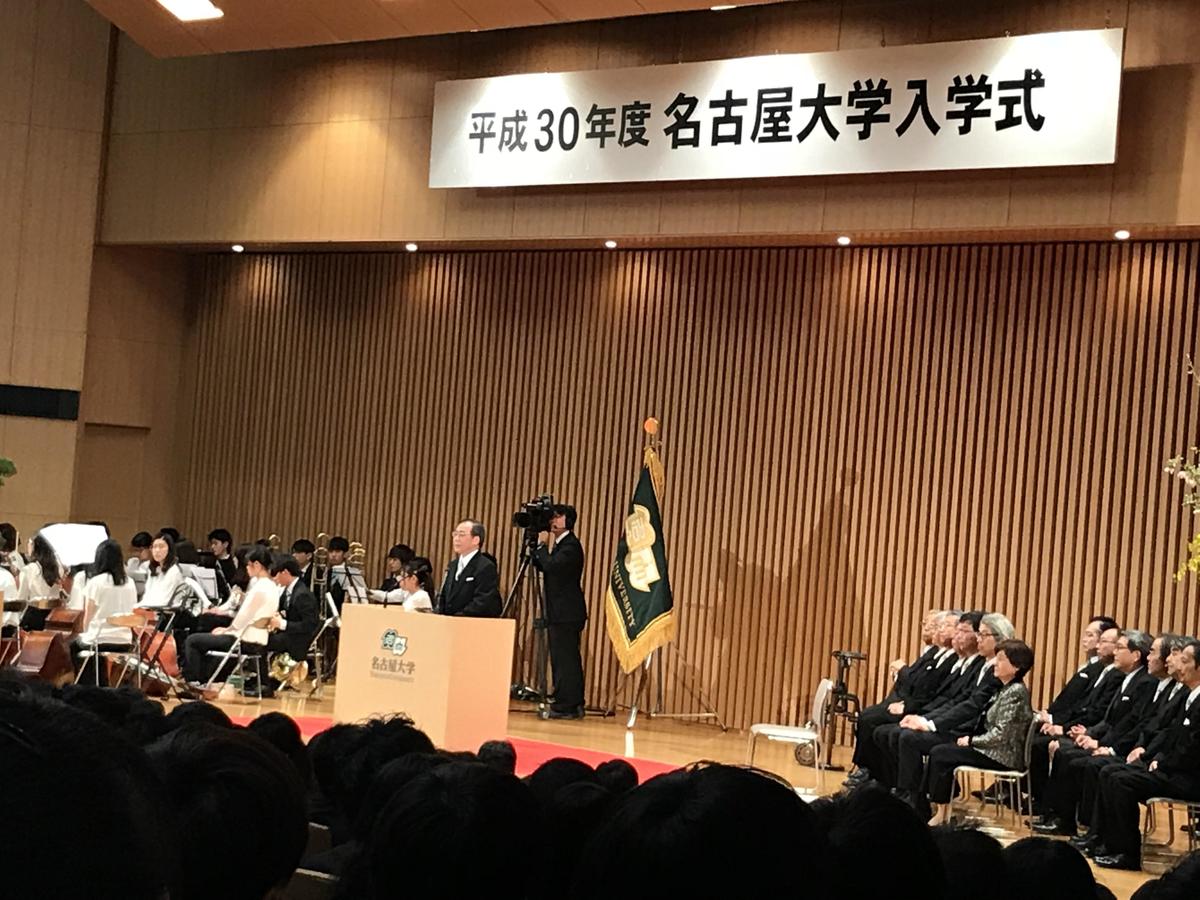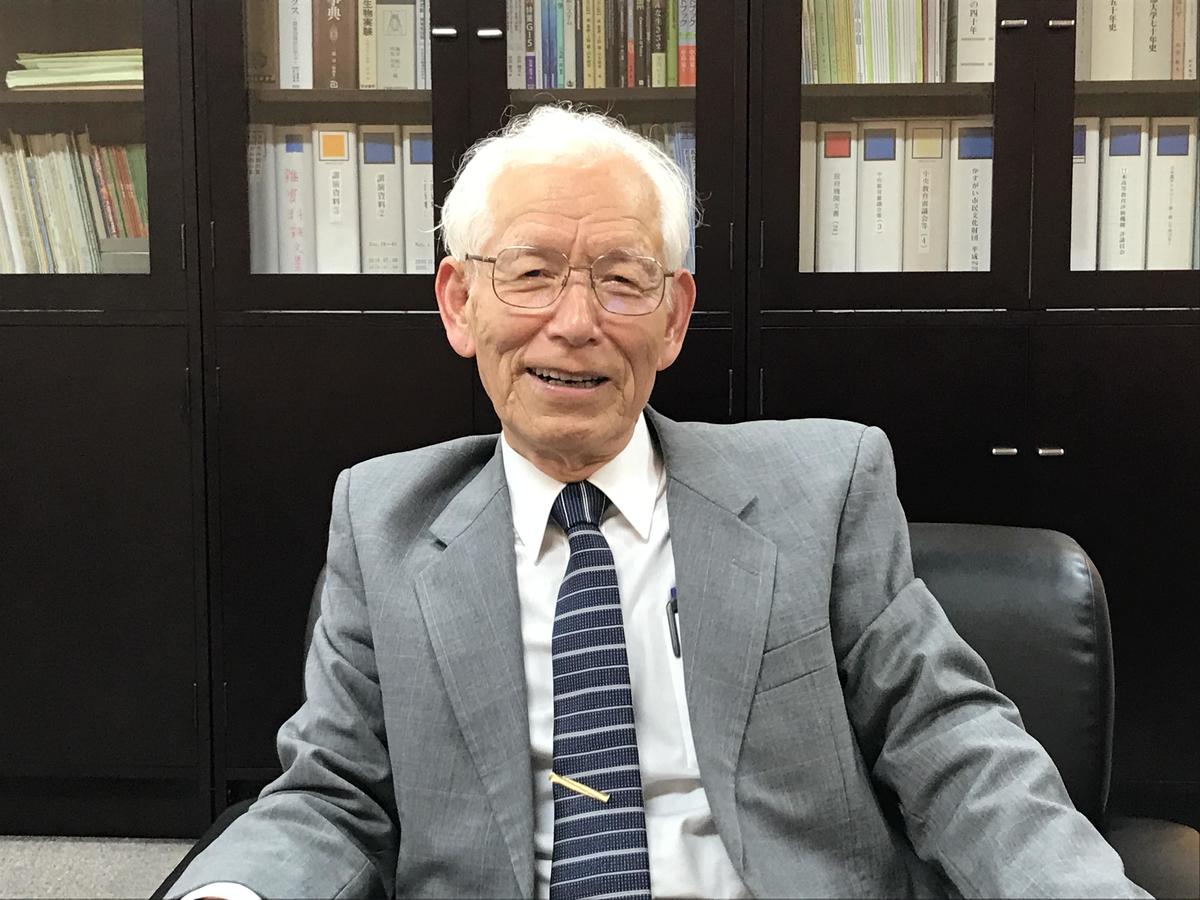April 23, 2018
What Is a "Courageous Intellectual"?
Nagoya University's human development goal is to foster "courageous intellectuals." President Seiichi Matsuo used the term to fire up students in his commencement and matriculation addresses this spring. It can be heard in various settings here at Meidai alongside "free and vibrant." But what is a courageous intellectual? And where did this phrase come from?
 In his matriculation address, President Matsuo encouraged incoming students: “Nagoya University is the place to seize the opportunity, and to challenge yourself, to evolve into a courageous intellectual.”
In his matriculation address, President Matsuo encouraged incoming students: “Nagoya University is the place to seize the opportunity, and to challenge yourself, to evolve into a courageous intellectual.”
I first encountered the phrase when visiting Professor Yasuhiro Suzuki at the Disaster Mitigation Research Center back in February 2016. On the occasion of the fifth anniversary of the 2011 earthquake and tsunami, I had come to interview him on "the responsibility of scientists." I asked him about the responsibility scientists have toward an issue forced on us by the disaster: how to prepare for so-called "low-frequency mega-disasters," disasters that happen very rarely, but with cataclysmic results. After the 2011 disaster, Prof. Suzuki had to make a severe criticism when surveying an active fault running through a nuclear reactor site with the Nuclear Regulation Authority. Based on that experience, he said this at the end of the interview piece, which I titled, "Don't Shut Your Eyes to Inconvenient Truths."
"What worries me is that young researchers tend to avoid social commentary. It may be partly because they won't be praised but criticized for making such commentary. Science exists chiefly for the welfare of society, so researchers have a duty to break out of their silos and talk. So how can universities, research institutions and academic societies foster the 'courageous intellectuals' society needs? Their task is to foster this quality not just in spirit, but also by developing specific educational systems, including assessment criteria."
Though not mentioned in the article, Prof. Suzuki told me that "courageous intellectuals" was originally mentioned in the Nagoya University Academic Charter, which was formulated in the year 2000, ahead of all other national universities in Japan. Minoru Matsuo, president at the time of its establishment, was also Prof. Suzuki's mentor, and since then Suzuki has been aware of the social responsibility of scientists and has made conscious efforts at social commentary. The phrase left a strong impression on me as well, since I had already felt the importance that scientists be publically vocal.
Since coming to Meidai, I've re-encountered "courageous intellectuals" on various occasions with different definitions. The current president Matsuo in a matriculation address described courageous intellectuals as "people who, in addition to advanced, specialized knowledge and skills, possess such qualities of character as a high aspiration to benefit society, a broad perspective, an appreciation for diversity, an open, receptive mind and the leadership to get things moving; they are people who confront and boldly tackle problems of humanity." And again on the student side: Ryota Mitsuno, for example, who graduated this spring and launched a start-up company, commented humorously in a roundtable discussion with the president: "I wonder if courageous intellectuals are the people who have failed the most. They jump in and fail. And by doing it over and over, they grow and eventually learn to do anything. My life, in any case, has been only failures."
It seems the term has gained currency across campus, with each bringing their own interpretation.
How, then, is it used in the Academic Charter? The academic charter is organized into four sections, the guiding principles of scholarship at Nagoya University. The first, Fundamental Objectives: Research and Education, states the following.
(1) Nagoya University, through its creative research, shall pursue truth and produce world-leading intellectual achievements.
(2) Nagoya University, through an education that values independent thinking, shall foster individuals who possess intellectual courage, the power of rational thought, and imagination.
Both are very concise expressions of Nagoya University's research and educational goals. That imagination is listed alongside rational thought as a faculty that should be instilled in courageous intellectuals draws my attention, but they are anyway quite simple.
What kind of thinking went into this concise wording? To find out, I visited Professor Emeritus Okitsugu Yamashita, who helped write the Academic Charter during his term as vice president of Nagoya University. He later became president of Chubu University and is now, since last year, academic advisor emeritus of the same school.
 Professor Emeritus Okitsugu Yamashita
Professor Emeritus Okitsugu Yamashita
According to Prof. Yamashita, the Academic Charter is like the Constitution of Nagoya University, describing only the fundamentals and sparing the details to leave room for a variety of interpretations. What's important, he says, is to be creative in one's interpretation and to put the words into practice. For example, he wants everyone to think for themselves what courage intellectuals need to have.
The impetus for creating the Academic Charter under the then-President Matsuo came from the move to incorporate Japan's national universities as part of an administrative reform. Driven in part by the hopeful observation that it could forego incorporation if it reforms itself, around the turn of the century, Nagoya University began a project to envision and create the kind of university it wanted to be. Deciding anything proved difficult, however, as even the slightest objections from schools in the hearing process kept them from forming a consensus; this system would need to be changed too. To address this issue, the focus shifted toward first creating a standard for value-based decisions, a so-called constitution for the university as a whole.
In March 1999, an organizational reform study group was created within the Education and Research Council. And below that a future planning subcommittee composed of the school deans was formed and tasked with deliberating on the future of the university. Vice President Yamashita chaired that committee.
Yamashita's first step was to draft a 40-page academic plan during his summer vacation. He presented the plan to the committee at its first meeting in late August -- only to have so much debate that it took an hour to cover only half a page. Such a pace wouldn't do, so Yamashita boiled the document down to a single-page list of items, more like a table of contents of the academic plan. In response to the criticism that the plan felt too generic, Yamashita added "Nagoya University" to the beginning of each item. His idea was, first let's decided on a framework of principles we want to pursue. This became the model for today's Academic Charter, which begins every sentence with "Nagoya University."
Decisions also had to be made quickly. In parallel with discussions in the monthly subcommittee and in the organizational reform study group, to which they reported their conclusions, Yamashita also met regularly with President Matsuo and Professor Keiichiro Tsuji, another vice president. Interestingly, President Matsuo's undergraduate background was civil engineering, Prof. Tsuji's was literature, and Yamashita's was agriculture. Based on the study group's discussions, the three talked and further refined the draft while taking into account circumstances within and outside the organization, such as the move toward incorporation, and Yamashita brought the results before the study group.
It was at the seventh subcommittee meeting in February 2000, the following year, that Nagoya University's academic plan and Academic Charter took their final shape. In the meantime, the study group met twice, and a combined meeting of the study group and subcommittee was held once. The three-person discussions with Yamashita and company were held as many as fifteen times, often late into the night, sometimes over drinks. As Yamashita recalls, the in-depth discussions and sharing of perspectives between the three leaders and subsequent committee discussions based on them played a key part in their ability to finalize the documents in less than six months after discussions began.
On February 15, the Education and Research Council approved the Nagoya University Academic Charter, and on February 23, an all-campus assembly on the university's future was held in the Toyoda Auditorium. Some 500 people turned out.
To leave out the detail and describe only the essence was also the consensus of the three. For example, the university's goal in research is "world-leading intellectual achievements." Instead of arguing endlessly over where the university should sit in the global rankings, they settled on "world-leading." This carried over into current President Matsuo's policy of building a "world-leading research university."
What about courageous intellectuals? How about someone with a critical mind and the courage to protect academic freedom and the university's self-governance, without catering to authority? Or someone who says and acts on their good conscience, and has the guts to do what needs to be done, even if they have to go it alone? The discussion on this topic, too, might never end. The word "critical" is also too narrow. In a setting like a university where there are lots of lone wolves, a word that can be interpreted each to his liking is ideal, says Yamashita. Choose a hundred people and you should find a hundred different ways of being a "courageous intellectual."
But these courageous intellectuals must also "possess the power of rational thought and imagination." The importance of rationality goes without saying, but what about imagination? According to Yamashita, intellectuals -- humanist and scientific alike -- must be able to think from all angles and on a time scale from past to future. They complement the digital with the analog. Knowledge with wisdom.
Hearing this, I had to agree. I've always sensed the importance of imagination. I've even talked about imagination in forums discussing higher liberal arts education and engineering education.
I personally define imagination as the ability to 'see' what can't be seen or what may happen based on what can be seen or what has already happened; in other words, the ability to expand one's thinking and ideas beyond a certain time and space. This ability is particularly needed among practitioners of the sciences and technology, which are having an enormous and growing impact in times and places beyond what's familiar, but I'm sure it's also necessary in intellectuals more broadly.
Cultivating the power of imagination, or the ability to see what can't be seen in the current time and space, requires mustering all of one's knowledge, experience and sensitivities. Therein lies the meaning of a liberal arts education.
Philosopher Kiyokazu Washida asserts that "imagination is our most important tool for living." In a matriculation address as president of Osaka University, he stated, "At all times, I want you to carry with you the ability to imagine others." He went on to explain that to "imagine others" means to try to understand other people from their perspective, and that this ability is not about broadening your current conceptions but seeing yourself from a different viewpoint.
"Individuals who possess intellectual courage, the power of rational thought and imagination" thus has deep connotations, I think. It means to perceive the world with a rational and imaginative mind and to possess the courage to act in service of how the world should exist, whatever that may be.
As far as words delivered to graduating students go, "Be not a fat pig but a lean Socrates" are perhaps the most well-known in Japan. Kazuo Okochi, president of the University of Tokyo, is credited with having spoken them at a commencement in 1964.
There are three misconceptions surrounding these words, however, according to a commencement speech given three years ago at the University of Tokyo College of Arts and Sciences by then-dean Yojiro Ishii. First, said Ishii, they are not the words of Okochi himself, but of 19th-century philosopher John Stuart Mill in his book Utilitarianism. Okochi's manuscript includes "Mill said," so it seems the news coverage was inaccurate. Next, the original passage goes like this: "It is better to be a human being dissatisfied than a pig satisfied; better to be Socrates dissatisfied than a fool satisfied," so Okochi was probably paraphrasing from hazy memory. And lastly, the words weren't even spoken, but in fact skipped over for some reason. Because news reports were based on the manuscript, however, the rumors still spread.
"Quite simply, the whole proposition is entirely mistaken; not one part contains truth. Yet this phantom episode has been told and retold as if it were truth," said Ishii. In an age when dubious information abounds, a sound critical mind that questions everything is the essence of liberal arts education.
By the way, the words given to graduates by Junichi Hamada this that year, the last in his term as president of the University of Tokyo, were "tough and global."
A sound critical mind is also the heart and soul of "courageous intellectuals." This slogan seems to have grown deep roots at Nagoya University in the nearly 20 years since it first appeared. As each of us reflects on its meaning and puts it into practice, I would like to see those roots delve deeper, and from them a great tree grow. Of course, according to Prof. Yamashita, the Academic Charter will be updated with each generation--with the courage to change what needs to be changed.

 Subscribe to RSS
Subscribe to RSS